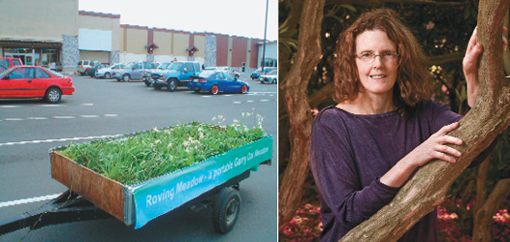Connecting science and art
Focus Magazine July 2010
BRIAN GRISON
When the Garry oak meadows of Langford were threatened, naturalist Fran Benton turned to art and politics.

Considering that she is an artist, it is interesting that Fran Benton’s first passion is natural history, a branch of science. With a degree in biology and geography from the University of Victoria, her original career was field biology and park-naturalist. As a matter of fact, Fran Benton “discovered” art through the necessity to improve her drawing skills for her scientific research. As she explains: “Almost all field biologists have a bit of art training, as we often need to draw the plants, geography, and animals we work with. Because I already did a lot of fun art stuff as a kid, I enjoyed drawing for my fieldwork….[ For a time I had] a job at the Swan Lake Nature Sanctuary. Since we had no illustrations in the nature centre, I started to make drawings and paintings for the centre.” But with no art training, she says she found her work “unsatisfactory.”
Thinking like a scientist, and without a conscious decision to pursue an artistic practice, Fran Benton changed her work schedule so she could attend the two-year art program at Camosun College, to learn to draw plants properly. Even though Camosun College did not have botanical illustration courses, she says, “after two weeks I was hooked…I knew this was what I wanted to do for the rest of my life.”
After completing the Camosun College program, she earned a Batchelor of Fine Arts degree at the Emily Carr College of Art and a Masters in Fine Arts degree at UVic. She now teaches full-time in the Art and Design Department of Vancouver Island University in Nanaimo. While in a formal sense Fran Benton is no longer a field researcher in natural science, the spirit and intention of her art practice are the equivalent, and every bit as valuable to society and the local natural landscape.
In the early 1990s, Fran Benton and her husband moved from Saanich to their “first real home” in Langford, at the time, as she describes it, “a scruffy but charming suburb of Victoria with lots of beautiful wild areas.” Unfortunately, not long after their arrival in Langford, the recently-elected mayor embarked on huge land development projects that destroyed virtually all the beautiful and rare local Garry oak meadows; almost none of it was preserved as parks, bird sanctuaries or other natural spaces. Garry oak woodlands that had been cultivated by local First Nations people, as well as their spiritual sites, were bulldozed and replaced by all those “big box” stores surrounded by acres of parking lots that Langford is now infamous for.
Interestingly, but sadly, Fran Benton’s attempts to stop this destruction displayed the naiveté of the scientist who believes that simple rational argument must naturally change the mind of even the most crass politicians and developers. Thinking this was a “one-off kind of thing,” she organized presentations to council and the mayor. However, these government officials and politicians were “unconcerned with the voices of their constituents to slow down the development.” She then put up posters to educate her neighbours about the loss of wild places and natural landscape, trees, flowers and local animals in their community. Finally, because she realized that her mission was slowly driving her to despair, she turned to art as a more gentle tool of positive propaganda.
She developed projects to express and release her from the anguish she felt on behalf of the land where she lived. In one project she made little bags containing tiny ceramic claws as talismans accompanied by thank-you notes that she hung in trees she knew would soon be cut down. In the notes she explained to the trees that their services were no longer needed in the municipality of Langford; the tiny claws were the equivalent of the gold watch, that cheap symbol of forced retirement and arbitrary dismissal.
In another project, “Roving Meadows,” Benton set out to save some of the beautiful local plants. As an experienced and dedicated plant salvager and propagator— both as scientist and gardener—she had noted all the camas lilies and other plants in a 30- acre Garry oak meadow near her house that was being surveyed for a shopping mall. She received permission to explore the meadows. She was seeking a small plot that she could remove as a single block of earth, with all the flowers and plants in place. Once she found it, she carefully transplanted the whole block on a four-by-eight-foot trailer.
Several months later, when the shopping mall was complete, she drove the trailer-cumplanter to the exact spot where it had grown before the new parking lot smothered everything natural. She spent an afternoon giving away plants and cuttings, and handing out pamphlets that explained the necessity to save a small section of that meadow in a giant flower box. Later, the Swan Lake Nature Sanctuary agreed to plant the little section of homeless meadow in its own beautiful park.
Eventually Langford became so unwelcoming that Fran Benton and her husband sold their house and moved to a quiet street in a beautiful, naturally-landscaped neighbourhood in Mill Bay. Her whole high-ceilinged basement is a busy art and study centre where she continues to make art that honours both the beauty of the natural world and her scientific/political advocacy for it.
Brian Grison is a Victoria based artist, art teacher and writer.
Tags: Publications